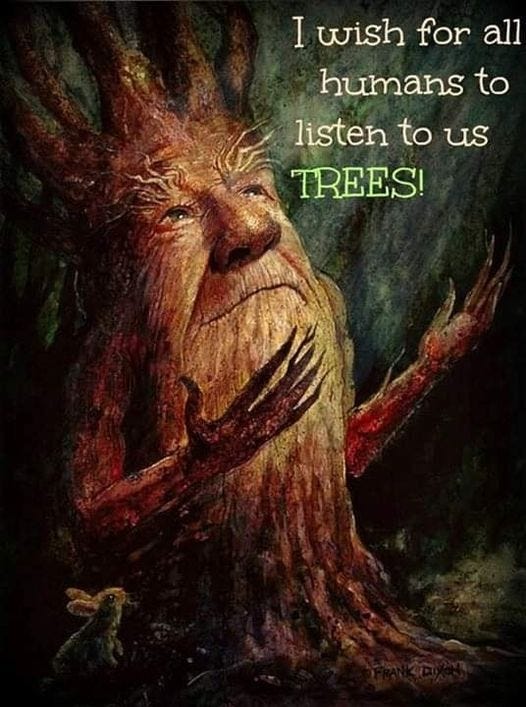Hey there~ This is the free version of A Mystic’s Journal. Thanks for reading! It would mean a lot if you’d share it on social media or recommend it to a friend! We also depend on paid/premium subscriptions! (Premium readers will get more bonuses in 2023!) See button below!
I’ll have my first web-class available for you this month. I’m shooting for the middle of March. Here is a link to the description page: Doorway to Spirit
Coming Soon! the first Online Web-Class for A Mystic's Journal: Doorway to Your Spirit Guides (A Personal Notebook)
WEB-CLASS ~ The web-class will be five days long so you can access it anytime you want. Investment is $40. Click Here» Doorway to Spirit for early information. I am still working on posting the class.
There is a story of a young Buddhist adept monk. He was very good at emptying his mind. While sitting under an orange tree one day, blossoms started to fall all around him.
The gods said to him: “We are blessing you because of your words about emptiness.”
“But I didn’t speak,” he said.
They continued to shower him with orange blossoms and said, “You did not speak, and we did not hear. That is true emptiness.”
I take stock in the many experiences I had as a kid. And trees are included. My cousin Johnny and I used to play around, under and on the branches of a large pear tree in our front yard. You could always find us up in the tree, dangling from the branches or sitting on a higher branch, just talking.
One particular branch was our favorite to sit on, since it was close to the trunk and felt secure. One day we both looked at the bark on the branch and noticed something strange. There were two symbols next to each other. One was the outline of a foot, the other was an eyeball!
Wow, Johnny and I decided it must be the name of the Tree Spirit: Mr. FootEye. Even though the tree is long gone from that front yard, Mr. FootEye still peeks into my mind once in a while.
Trees and Our Spiritual Selves
At the spiritual level, trees help us become better in tune with and more compassionate toward our surroundings, more aware of our connections with something larger than ourselves. In mythology, trees are sometimes portrayed as the home of nature spirits. We even have a special word — dendrolatry — in reference to the worship trees.
Perhaps this is why sacred groves have been an important part of various cultures throughout the world. Examples include cedar groves in Lebanon, redwood groves along the Pacific coast of North America, the Shaman forests in south Peru and the Garden of Gethsemane in Israel. In Japan, a large number of Shinto and Buddhist groves are cherished as sacred natural sites, while people in other parts of the world and with different religions have established specific wooded areas as monastic groves.
We also look to trees for healing — not only in the medicinal sense, but for spiritual healing, comfort and solace. We thus find trees in therapeutic gardens and cemeteries and understand why some individuals request having their ashes buried at the foot of a tree or scattered in a beloved forest.
Meaning of the Tree of Life
The tree of life symbol is ancient, almost as old as humans. This symbol has been represented in Christianity, Ancient Egypt, as well as Buddhist, African, Turkish and Celtic cultures.
Christian references: In the Bible, the garden of Eden had a tree forbidden to Adam and Eve: the tree of eternal life. The tree of life represents wisdom and the love of God.
Celtic Culture: Celts cherish trees for their spiritual connections to family, ancestors and deities. The tree of life represents the afterlife, and connection between the earth and heaven. The bond and affection to trees is so deep that Celts believed the actual trees were their ancestors, gatekeepers to the Celtic Otherworld.
Ancient Egypt: In Ancient Egypt, the tree of life’s branches represented the heavens and symbolized abundance. Alternatively, the roots reaching into the earth represented death.
African Culture: There is a tree called the Baobab tree, which is generally regarded as the tree of life. Since the Baobab tree produces fruit despite the dry climate it is treated with reverence and high esteem as a provider of life and nourishment.
Buddhism: Buddha reached enlightenment under the sacred Bodhi tree. In Buddhist culture the tree of life is symbolic of enlightenment and existence.
There are many interpretations of the tree of life symbol, most popularly it represents connection and unity. It represents Connection, Strength, Growth, Rebirth, Family, Serenity. It keeps these attributes to hold all of humanity together.
Some of the information gathered for this article came from the House of Lor.
Please consider subscribing to my journal. Just click the ‘subscribe’ button. You can be a free subscriber or bump it up a notch (for only $5/mo. and the Inner Circle) and get so much more in your email box. Thanks!
Don’t want to commit to the weekly thing? But still would like to support me in my work? I would greatly appreciate a Cup of Coffee. Buy me a cup?
Melissa Leath writes A Mystics Journal on Substack. She supplies outrageous metaphysical babble/rant from a modern-day mystic's viewpoint and provides workshops about empowerment and psychic/metaphysical development. Her books Psychic Integrity, The Respected Practice of Modern-Day Mystics (Balboa Press, division of Hay House Publishing) and Does Your Child See Sparkles? are available through Amazon and Barnes & Noble. Melissa’s long-term study includes years of group development, platform mediumship, meditation, becoming a spiritual medium and minister and a BA in Metaphysical Counseling. She has worked with 10s of thousands of clients in USA and other countries, taught development classes for 12 years and settled into online workshops.
Please contact Melissa at melisssaleath@gmail.com.








